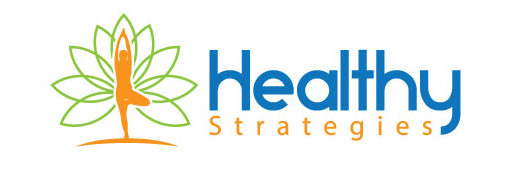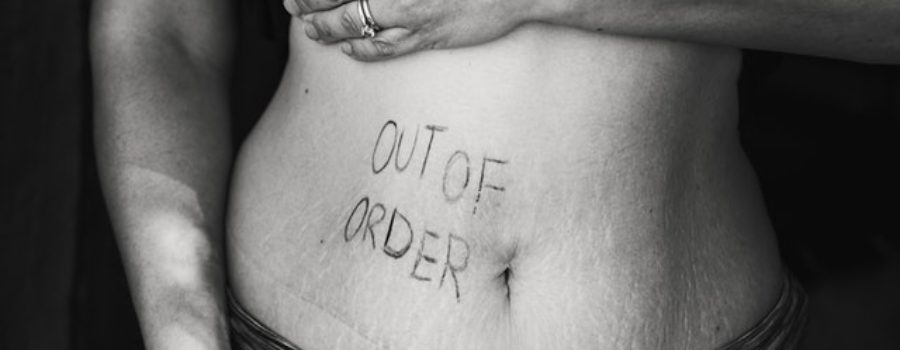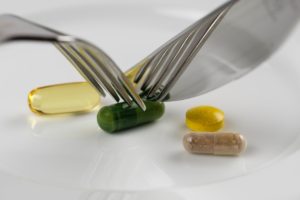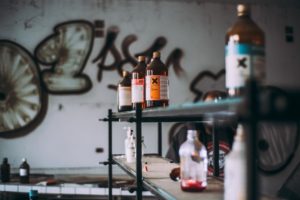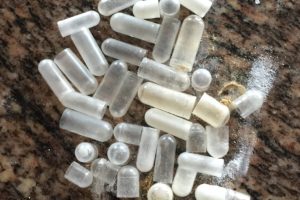SIBO and Associated Symptoms
I don’t like to use this kind of language in my posts, but I’m only going to say it this once: SIBO is really a bitch! Small intestine bacterial overgrowth (SIBO), not only is producing a lot of abdominal discomfort, but so many other satellite symptoms. Even worse, is often missed as a diagnosis especially when the associated symptoms are more pronounced than the abdominal discomfort.
The significantly more numerous bacteria in the small bowel produce increased fermentation of carbohydrates from starchy foods, from many fruits and some vegetables. This process leads to increased intestinal gas that’s responsible for the pain, bloating, and changes in bowel movements. If it’s predominantly more hydrogen released there is associated diarrhea, while increased methane is linked with constipation; the type of gas being released depends on what type of bacteria predominates.
Patients with SIBO suffer of symptoms usually associated with other diseases, such as fibromyalgia (widespread muscle pain), restless-leg syndrome (the urge to move the legs), interstitial cystitis (painful bladder syndrome), or rosacea (redness and acne-like pimples over the nose and central portion of the face). These associated symptoms, which treating physicians often do not connect with SIBO, could cause a great deal of discomfort and are often the reason why patients seek medical advice.
The intermittent redness of my face centered around the nose triggered my attention first. I didn’t pay much mind to it, because it’s a mere cosmetic effect and I’m not vain anymore, if I ever was. This reddish discoloration was considered one of the lupus features of my mixed connective tissue disease, until I understood it was more likely to be SIBO-related rosacea.
What bothered me the most though, were the associated urinary symptoms that often made me run to the bathroom. Why is this urge to urinate happening? Some days were worse than others, but for a while I wasn’t able to make any correlations. I thought it may be connected with SIBO, but which of the intestinal gases, hydrogen or methane, were responsible for this? I didn’t find any answers pertaining such a connection.
Methane and hydrogen do not smell, but SIBO sufferers (myself included), can detect foul, rotten-egg smelling stools. Where is this coming from? After I did my related searches, I learned that a third excessive gas in SIBO can be hydrogen sulfide and this explains the rotten-egg smell. And that’s not all, hydrogen sulfide relaxes the small intestine muscle producing constipation while on the bladder muscle produces contraction. Oh, this definitely justifies why I have to run to urinate at times!
Hydrogen sulfide producing bacteria are part of our normal intestinal flora and hydrogen sulfide (at the small, physiological amounts), has important functions in our body. Sulfur components are found in onion, garlic, and the cruciferous vegetables like broccoli, cauliflower, kale, or cabbage. Sulfur from these sources, along with certain amino-acids derived from proteins, contribute to the body’s synthesis of glutathione—a very important antioxidant.
Problems start when there is excessive hydrogen sulfite. This is when SIBO sufferers notice bothersome constipation or the urinating urge. The way these effects occur are not fully explained yet, but hydrogen sulfide is considered a neurotransmitter affecting, at the neuromuscular junction, the nerve endings that trigger the smooth muscle activity.
Why should it be excessive hydrogen sulfide production? Because of an increased number of the bacteria that generate it. Some of these have very suggestive names, like Desulfovibio, Desulfobacter, but other bacteria present in our intestine, like E. coli, Klebsiella, Enterobacter, Clostridium—all of which are significantly increased in number in SIBO—also have the enzymes needed to produce hydrogen sulfide.
Now that I understood some of the hydrogen sulfide effects, I realized the times when I had to rush to the bathroom to urinate were coinciding with my eating increased sulfur-containing cruciferous vegetables and turmeric. I did this hoping to improve my glutathione production. Since I love these vegetables which are also loaded with numerous antioxidants, I know that at least for now, I need to drastically cut down on fruits during the days I decide to eat them. Luckily for me (and probably for almost everyone else), the urinary effects from hydrogen sulfide do not last more than a day, unless there is ongoing sulfite-containing nutrient supply.
Hydrogen sulfide is a gas that easily crosses cells’ membranes, making its appearance and effects at numerous other sites, not just limited to the intestinal or the bladder muscles. The entire vascular system has smooth muscle, therefore can be influenced by hydrogen sulfide. The vasodilatation effects may be responsible for the redness and other associated manifestations from rosacea. Maybe certain “out of place,” non-menopausal hot flushes that some SIBO patients experience, can be blamed on the vasodilators effects of hydrogen sulfide.
These can add to similar symptoms that can occur because of a different dietary vasodilator not taken into account. It’s a salt additive used to prevent clumping in many brands of fine-grain salt (including sea salt), called yellow prussiate of sodium or sodium ferrocyanide. Not to worry, this is not a cyanide poison! It’s rather a substance chemically related to a more powerful vasodilator—sodium nitroprusside—used intravenously to treat severely increased high blood pressure.
I while ago I understood that the vasodilator effects of the yellow prussiate additive were the reason for my unexplained “heat waves,” and this was repeatedly verified on other family members and many other acquaintances ever since. As I haven’t used salt containing this additive, after learning about the vasodilator properties of hydrogen sulfide, I finally realized that the reappearance of the heat waves is now due to the increased production of this gas in my intestine.
But that’s not all! I also noticed my achiness worsened because of SIBO and there is an explanation for this too. Certain substances (called lipopolysaccharides), derived from the membranes of the numerous hydrogen sulfide producing bacteria, as well as the other types of bacteria—much more numerous in SIBO—stimulate our immune cells to release pro-inflammatory substances, such as TNF alpha and cytokines (such as interleukin IL-6), which can be responsible for the myalgia (body aches) symptoms.
In restless leg syndrome, manifestations are usually more pronounced at night, when we have to keep still in order to fall asleep; by walking around in the daytime they are less bothersome, hence less noticeable. Restless leg symptoms were not explained by the effects of hydrogen sulfide. I read some hypothesis that they may be connected to the entire SIBO-related inflammatory process, that can induce decreased circulating iron along with decreased amount of iron available to the tissues.
My blood tests don’t show low circulating iron and I notice my restless symptoms when I have nagging, increased overall achiness, not when it’s severe. Based on the way I feel, I presume that the pro-inflammatory cytokines responsible for the increased body aches, may contribute to the restless symptoms. When I’m achy I need to move, hoping to get more comfortable and my restless symptoms improve when the achiness diminishes. I’m also wondering if the hydrogen sulfide can act as a neurotransmitter not only in the smooth muscle, but in the skeletal muscles as well.
As I realized my intestinal and colonic bacteria are producing loads of hydrogen sulfide, I decided to limit some of the sulfite foods. Many processed or packed foods have sulfites added to them, but that’s not really my concern because I don’t eat them. Here are some examples, though: dried fruits (unless organic), fruit preserves, canned fruits and juices, vegetable juices, baked goods, wine, beer, condiments, and others. Some of the names for sulfur ingredients that appear on the labels are sulfur dioxide, potassium bisulfite or metabisulfite, and sodium sulfite or sodium bisulfite and metabisulfite. Some medications can have some of these among the inactive ingredients.
My more important concerns are cruciferous vegetables, which I like a lot, and the turmeric powder that I sprinkle on many foods and salads. After I understood what was causing my urinary symptoms, I decided for a few days to cut out some of sulfur-rich vegetables. I had the very pleasant surprise that I was able to enjoy more fresh fruits, even a few pieces of the forbidden ones, without the feel that I needed to rush to the bathroom to urinate. This is why I decided to alternate the days when I eat these healthy vegetables with the days I indulge in fruits, and it works. I still do get some bloating but it improves over the next couple of hours.
Moreover, that foul, rotten-egg stool odor also diminished considerably. I don’t get my reddish facial discoloration as obvious as before these dietary changes, but the dilated small capillaries are still there and I can see them if I put my glasses on. Maybe they will fade away after SIBO would have resolved, but this is something I’ll have to wait and see and it’s not that important anyway.
The picture associated to this post does say OUT OF ORDER over the belly, but I feel and think that many other areas of my body are out of order because of this SIBO syndrome. Hopefully, this will get better when my microbial flora improves with the specific strains of probiotics I recently started. I don’t want to jinx myself by admitting it, but I can say I already noticed some benefits. These will likely be more obvious when I’ll be able to get a longer break from antibiotics.
Resources:
http://www.gidoctor.net/client_files/file/Turnbull_Chapter_Final.pd
